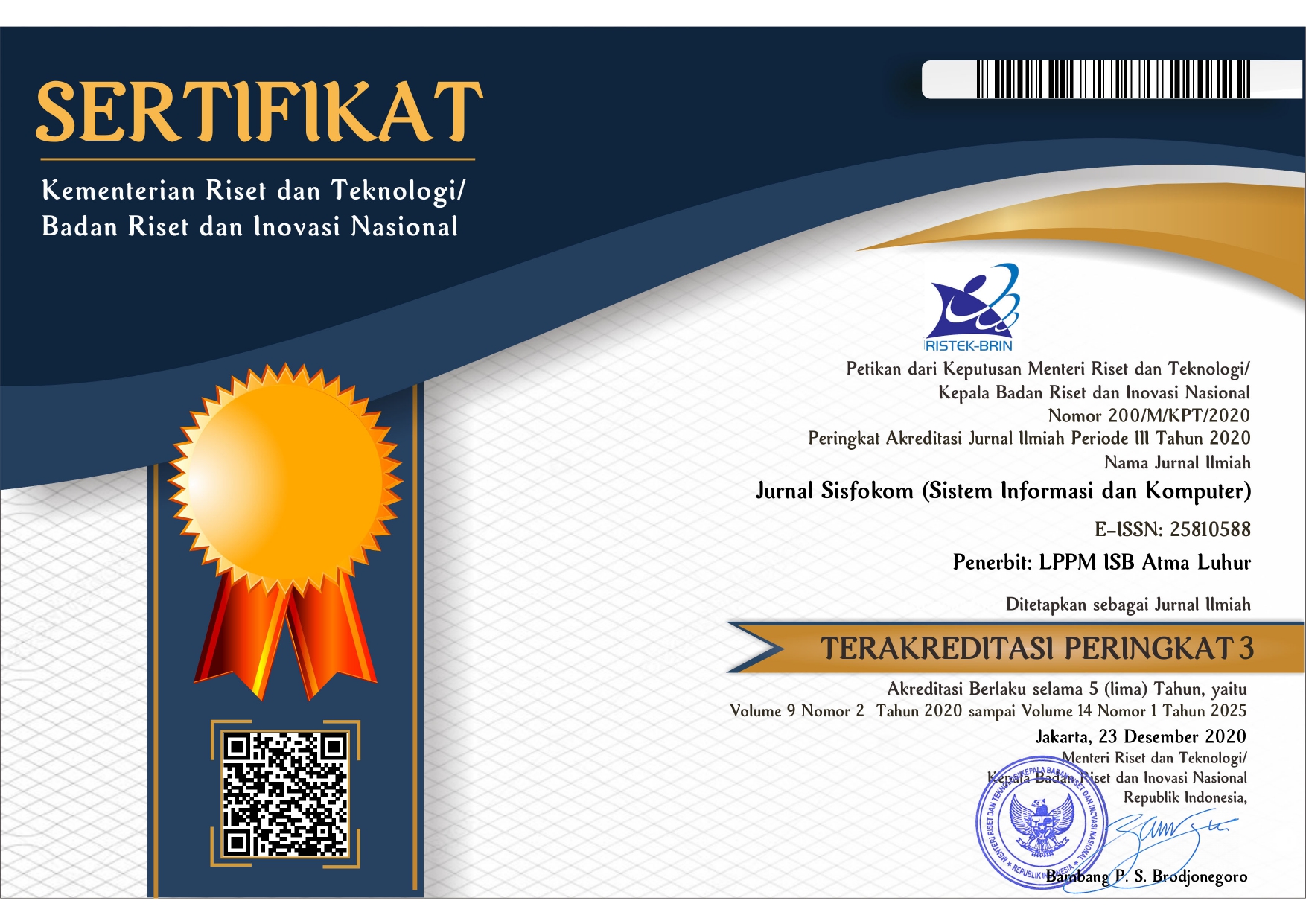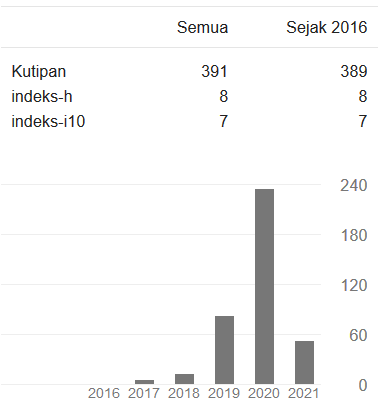A Systematic Literature Review on the Application of Machine Learning for Predicting Stunting Prevalence in Indonesia (2020–2024)
DOI:
https://doi.org/10.32736/sisfokom.v14i3.2366Keywords:
Stunting, Machine Learning, Nutrition Prediction, Spatial Data, Health ClassificationAbstract
Stunting remains a serious public health issue in Indonesia, with persistently high prevalence and long-term impacts on children's physical and cognitive development. The growing need for data-driven early detection systems has encouraged the adoption of technologies such as machine learning (ML) to more effectively predict stunting prevalence. This study employed a Systematic Literature Review (SLR) to examine 20 scientific articles published between 2020 and 2024, focusing on the application of ML algorithms in stunting research. Literature was sourced from Scopus and Google Scholar, with inclusion criteria covering studies relevant to the Indonesian context or comparable global settings. The analysis focused on the algorithms used, data types, model performance, and implementation challenges. The findings indicate that Random Forest, Support Vector Machine (SVM), and Artificial Neural Network (ANN) are the most frequently used algorithms, with prediction accuracy ranging from 72% to 99.92%. Dominant predictor variables include maternal education, economic status, sanitation, and spatial-temporal data. The main challenges include data imbalance, limited model interpretability, and a lack of external validation. In conclusion, machine learning holds strong potential to support predictive systems and data-driven policies for stunting prevention in Indonesia. This study recommends future research to focus on integrating spatial-temporal data, implementing Explainable AI (XAI), and conducting cross-regional validation to enhance model reliability and policy relevance.References
W. S. Lestari, Y. M. Saragih, and Caroline, “Comparison of Deep Neural Networks and Random Forest Algorithms for Multiclass Stunting Prediction in Toddlers,” 2024.
M. M. Islam, N. M. S. J. Kibria, and S. Kumar, “Prediction of Undernutrition and Identification of Its Influencing Predictors Among Under-Five Children in Bangladesh Using Explainable Machine Learning Algorithms,” 2024.
M. A. Haque, N. Choudhury, and B. Z. Wahid, “A Predictive Modelling Approach to Illustrate Factors Correlating with Stunting Among Children Aged 12–23 Months,” 2023.
C. N. Prabiantissa, L. N. Yamani, and M. Hakimah, “Implementation of Artificial Neural Network (ANN) to Construct Model for Stunting in Toddlers,” 2024.
S. Ndagijimana, I. Kabano, and E. Masabo, “Predicting Stunting in Rwanda Using Artificial Neural Networks,” 2024.
F. Bitew, C. S. Sparks, and S. H. Nyarko, “Machine Learning Algorithms for Predicting Undernutrition Among Under-Five Children in Ethiopia,” 2021.
D. M. H. Abid, A. Haque, and K. Hossain, “Factors Causing Stunting Among Under-Five Children in Bangladesh,” 2020.
M. Shahriar, M. S. Iqubal, and S. Mitra, “A Deep Learning Approach to Predict Malnutrition Status of 0–59 Month's Older Children in Bangladesh,” 2019.
S. I. Novichasari, A. R. Prananda, and D. Suwidagdho, “Using Support Vector Machines for Predicting and Mitigating Stunting in Early Childhood Education in Rural Semarang,” 2024.
S. Lonang, A. Yudhana, and M. K. Biddinika, “Analisis Komparatif Kinerja Algoritma Machine Learning untuk Deteksi Stunting,” 2023.
V. R. Saragih, A. Arnita, and Z. Indra, “Comparison of Supervised Machine Learning Methods in Predicting the Prevalence of Stunting in North Sumatra Province,” 2024.
B. Satria, T. A. Y. Siswa, and W. J. Pranoto, “Optimasi Random Forest dengan Genetic Algorithm dan Recursive Feature Elimination pada High Dimensional Data Stunting Samarinda,” 2024.
Juwariyem, Sriyanto, and S. Lestari, “Prediction of Stunting in Toddlers Using Bagging and Random Forest Algorithms,” 2024.
M. Daffa and P. H. Gunawan, “Stunting Classification Analysis for Toddlers in Bojongsoang: A Data-Driven Approach,” 2024.
F. M. Hidayat, Kusrini, and A. Yaqin, “Penerapan Algoritma Naïve Bayes untuk Klasifikasi Status Gizi Stunting pada Balita,” 2024.
K. Chen, R. A. F. Adriansyah, and C. Juliandy, “Classification of Big Data Stunting Using Support Vector Regression Method at Stella Maris Medan Maternity Hospital,” 2024.
G. Nduwayezu, C. Kagoyire, and P. Zhao, “Spatial Machine Learning for Exploring the Variability in Low Height-For-Age,” 2024.
Y. S. Dewi, S. Hastuti, and M. Fatekurohman, “Analysis of Stunting in East Java, Indonesia Using Random Forest and Geographically Weighted Random Forest Regression,” 2024.
N. Hasdyna, R. K. Dinata, and Rahmi, “Hybrid Machine Learning for Stunting Prevalence: A Novel Comprehensive Approach to Classification, Prediction, and Clustering Optimization in Aceh, Indonesia,” 2024.
X. Zhang, M. Usman, and A. U. R. Irshad, “Investigating Spatial Effects Through Machine Learning and Leveraging Explainable AI for Child Malnutrition in Pakistan,” 2024.
Downloads
Published
Issue
Section
License
Copyright (c) 2025 Emilda Indrisari, Hidayat Febiansyah, Bambang Adiwinoto

This work is licensed under a Creative Commons Attribution 4.0 International License.
The copyright of the article that accepted for publication shall be assigned to Jurnal Sisfokom (Sistem Informasi dan Komputer) and LPPM ISB Atma Luhur as the publisher of the journal. Copyright includes the right to reproduce and deliver the article in all form and media, including reprints, photographs, microfilms, and any other similar reproductions, as well as translations.
Jurnal Sisfokom (Sistem Informasi dan Komputer), LPPM ISB Atma Luhur, and the Editors make every effort to ensure that no wrong or misleading data, opinions or statements be published in the journal. In any way, the contents of the articles and advertisements published in Jurnal Sisfokom (Sistem Informasi dan Komputer) are the sole and exclusive responsibility of their respective authors.
Jurnal Sisfokom (Sistem Informasi dan Komputer) has full publishing rights to the published articles. Authors are allowed to distribute articles that have been published by sharing the link or DOI of the article. Authors are allowed to use their articles for legal purposes deemed necessary without the written permission of the journal with the initial publication notification from the Jurnal Sisfokom (Sistem Informasi dan Komputer).
The Copyright Transfer Form can be downloaded [Copyright Transfer Form Jurnal Sisfokom (Sistem Informasi dan Komputer).
This agreement is to be signed by at least one of the authors who have obtained the assent of the co-author(s). After submission of this agreement signed by the corresponding author, changes of authorship or in the order of the authors listed will not be accepted. The copyright form should be signed originally, and send it to the Editorial in the form of scanned document to sisfokom@atmaluhur.ac.id.









